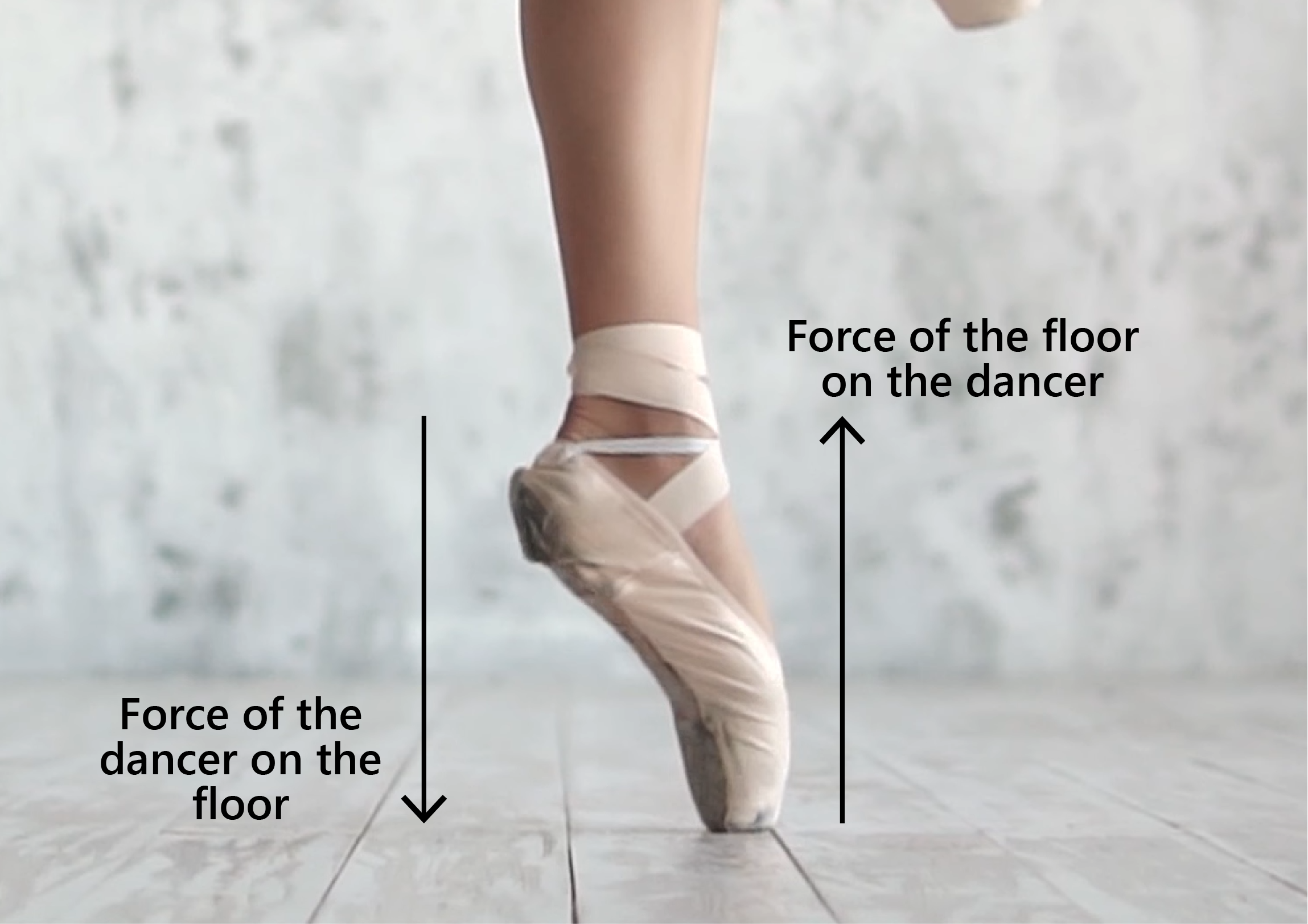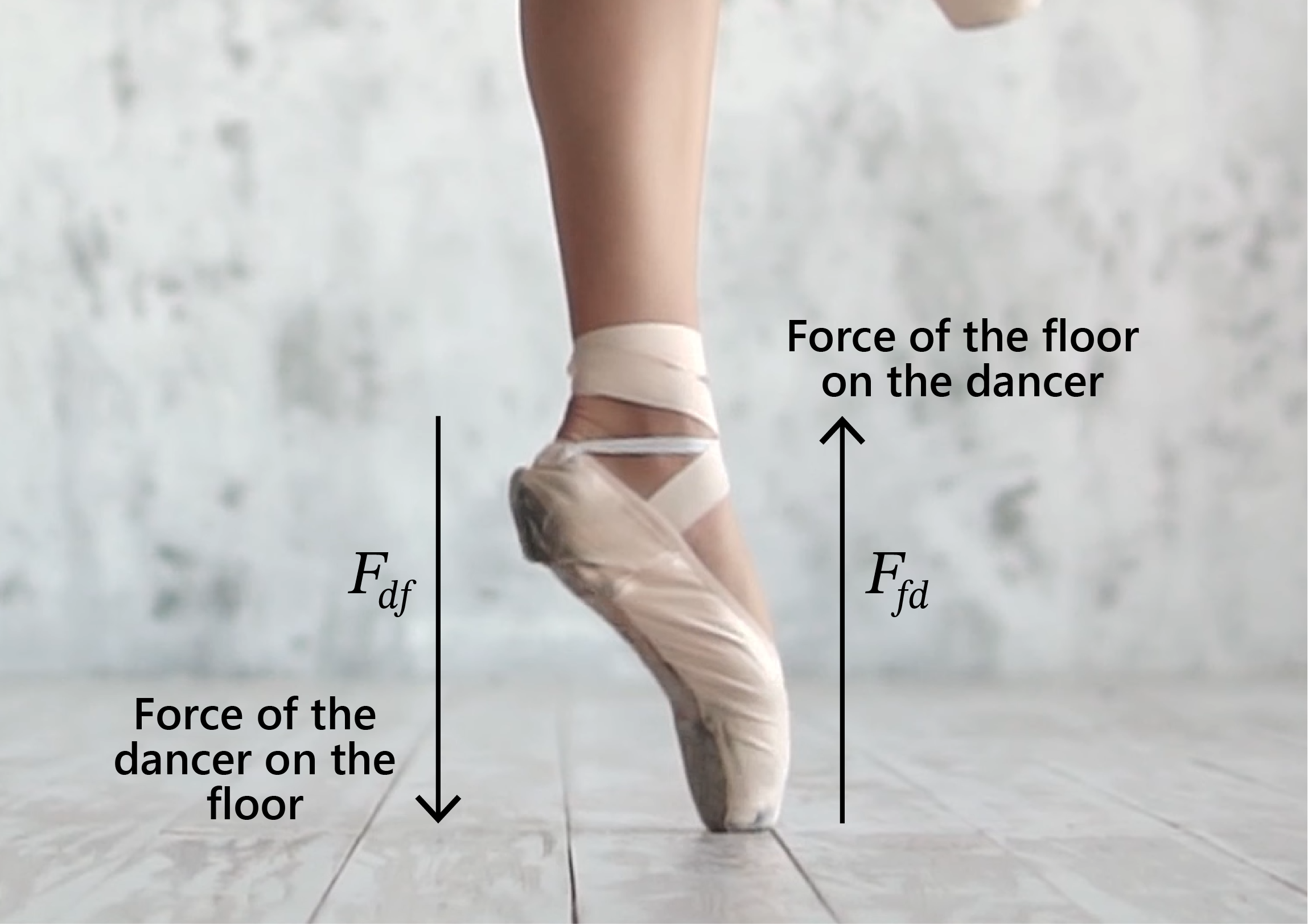
In this video, we will investigate Newton’s third law of motion: for every action, there is an equal and opposite reaction.
We will take a look at a few simple examples to illustrate the nature of Newton’s statement and its mathematical form and take a look at a couple of applications.
Newton’s Third Law of Motion
Newton’s third law implies that forces come in pairs, and that they are equal in magnitude and opposite in direction.
For example, if we look at the dancer spinning on one foot and look at the contact point between the dancer’s foot and the floor and state that the force of the dancer on the floor must be met by a force of equal magnitude from the floor but in the opposite direction, the forces are balanced, which is obvious in the sense that the dancer is not moving through the floor. Moreover, the floor is not moving through the dancer.

Now let’s take a look at the formulas behind this example. Note that the order in which the subscripts are written is important for keeping track of the action-reaction force pairs: we label the force of the dancer on the floor as \(F_{df}\) and the force of the floor on the dancer as \(F_{fd}\).

In this example, we can identify that the use of the notion of an action and reaction pair isn’t quite accurate. If we define the system as the dancer, we could say that she is providing the “action,” and therefore the floor is providing the “reaction.”
But we could also discuss the system from the floor’s frame of reference indicating that a cause-and-effect relationship depends on the frame of reference. In other words, the idea of action and reaction doesn’t illustrate the full concept. For this reason, Newton’s third law is better stated as “for every force, there is an equal and opposite force.”
The fact that Newton’s third law states forces come in pairs distinguishes a critical fact between it and Newton’s first two laws. The first and second laws relate the forces acting on a single body, while the third law describes the mutual forces exerted on each other by two bodies.
Newton’s Third Law Example
Let’s take a look at the physics of teaching someone how to throw a football.
First, look at the ball-hand force-pair the moment before the ball leaves their hand. According to Newton’s third law, the force of the hand on the ball, Fhb, and the force of the ball on the hand, Fbh, are equal in magnitude and opposite in direction.

This makes sense because the hand is not sliding past the ball and the ball is not sliding through the hand.
We could give a similar argument about the forces between the ball and the hand in the direction into and out of the screen you’re looking at.
From this perspective, we can see that the force of the thumb on the ball, pointing to the right, is paired with the force of the ball on the thumb to the left, and the force of the fingers on the ball to the left is paired with the equal and opposite force of the ball on the fingers to the right.
The instant the ball leaves their hands, there is no more contact point, so there is no more force between them, and Newton’s third law no longer applies.
Review
Before we go, let’s tackle a few review questions.
1. Which of the following is a better way to state Newton’s third law?
- For every action, there’s an opposite gravitational force
- For every force, there is an equal and opposite force
- The net force on a body in static equilibrium is zero
- All forces come in equal and opposite pairs
Newton’s third law states that for every action there is an equal but opposite reaction. A better way to say this involves changing the language to more accurately reflect that the notion of action and reaction is not as accurate as the language in choice B.
2. When a rocket launches from the ground, there is a pair of forces that are equal and opposite between the ground and the burning fuel streaming out of the rocket. This creates thrust, causing the rocket to lift off of the ground. Once the rocket is sufficiently away from the Earth’s surface, which of the following best explains why the rocket continues to accelerate?
- The rocket still experiences a residual “Earth Force” once it is in motion because the initial thrust keeps it going
- Once the rocket is no longer in contact with Earth, the force of gravity no longer influences the rocket, so the initial force accelerating it away from Earth continues to cause an acceleration
- The continued acceleration is provided by the collision of the newly burnt fuel molecules pushing off of the fuel in the air that just came out of the rocket
- The force of the Sun, the Moon, and the other planets begin to pull the rocket from Earth
3. A climber nearing the top of a cliff had one of her backpack straps break. She managed to catch it with one hand and keep the other hand on her climbing rope. She is now in the following position. What are the three main pairs of forces acting on her?

Pair 2: Climber and rope
Pair 3: Climber and cliff
That’s all for this review. Thanks for watching, and happy studying!